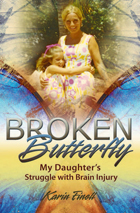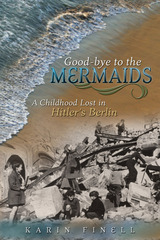2 books by Finell, Karin

Broken Butterfly
My Daughter's Struggle with Brain Injury
Karin Finell
University of Missouri Press
“It all began with the bite of a mosquito. Yes, with a bite of this pesky, but seemingly so innocuous little insect that had been sucking her blood. Not just one, but hundreds had punctured her arms and legs with red marks which later swelled to small welts. Who would ever have thought that our family's life would become derailed, that its tightly woven fabric would eventually fray and break—all from the bite of a mosquito?”
In November of 1970, the Finell family’s lives were changed forever by a family vacation to Acapulco. Seven-year-old Stephanie fell ill soon after their return to the United States, but her mother, Karin, thinking it was an intestinal disorder, kept her home from school for a few days. She was completely unprepared when Stephanie went into violent convulsions on a Friday morning. Following a series of tests at the hospital, doctors concluded she had contracted viral equine encephalitis while in Mexico.
After a string of massive seizures—one leading to cardiac arrest—Stephanie fell into a six-week coma. When she awoke, her world had changed from predictable and comforting to one where the ground was shaking. Due to the swelling of her brain from encephalitis, she suffered serious brain damage. Doctors saw little hope of recovery for Stephanie and encouraged her parents to place her in an institution, but they refused.
In Broken Butterfly, Karin Finell recounts the struggles faced by both her and her daughter, as well as the small victories won over the ensuing years. Little was known about brain injuries during that time, and Karin was forced to improvise, relying on her instincts, to treat Stephanie. Despite the toll on the family—alcoholism, divorce, and estrangement—Karin never gave up hope for Stephanie’s recovery. By chance, Karin heard of the Marianne Frostig Center of Educational Therapy, where Dr. Frostig herself took over the “reprogramming” of Stephanie’s brain. This, in time, led her to regain her speech and some motor skills.
Unfortunately, Stephanie’s intermittent seizures hung like the proverbial “Sword of Damocles” over their lives. And while Stephanie grew into a lovely young woman, her lack of judgment resulting from her injury led her into situations of great danger that required Karin to rescue her.
Karin’s love for her daughter guided her to allow Stephanie to fill her life with as many positive experiences as possible. Stephanie learned and matured throughtravel and exposure to music and plays,acquiring a knowledge she could not learn from books.
Stephanie wished above all to teach other brain injured individuals to never look down on themselves but to live their lives to the fullest. Through Stephanie’s story, her mother has found a way to share that optimism and her lessons with the world.
[more]

Good-bye to the Mermaids
A Childhood Lost in Hitler's Berlin
Karin Finell
University of Missouri Press, 2006
Good-bye to the Mermaids conveys the horrors of war as seen through the innocent eyes of a child. It is the story of World War II as it affected three generations of middle-class German women: Karin, six years old when the war began, who was taken in by Hitler’s lies; her mother, Astrid, a rebellious artist who occasionally spoke out against the Nazis; and her grandmother Oma, a generous and strong-willed woman who, having spent her own childhood in America, brought a different perspective to the events of the time. It tells of a convoluted world where children were torn between fear and hope, between total incomprehension of events and the need to simply deal with reality.
In one of the relatively few recollections of the war from a German woman’s perspective, Finell relates what was for her a normal part of growing up: participating in activities of the Hitler Youth, observing Nazi customs at Christmas, and once being close enough to the Führer at a rally to make eye contact with him. She tells of how she first became aware of the yellow star that Jews were forced to wear, and of being asked to identify corpses from a bombed apartment house. She also depicts the lives of people tainted by Hitler’s influence: her half-Jewish relatives who gave in to the strain of trying to remain unnoticed; a favorite aunt who was gassed because she was old and had broken her hip; and a friend of the family who was involved in the abortive putsch against Hitler and hanged as a traitor.
When American and British forces intensified air raids on Berlin in 1943, Finell observed the stoical valor of women during the bombings, firestorms, and mass evacuations. Not yet a teenager, she witnessed the battle for Berlin and the mass rapes perpetrated by conquering Russian and Mongolian troops. Order was restored after the American and British troops arrived. The Marshall Plan jump-started an economic recovery for West Germany, provoking the Russians to blockade Berlin. From 1948 to 1949 the Americans and British kept Berlin’s residents alive with the airlift. But even though food was flown in, the people of Berlin continued to go hungry. Deprivation forced Berliners to look inward and face their collective guilt as they withstood the threat of Soviet occupation during these postwar years.
This eloquent and touching story tells how a decent people were perverted by Hitler and how a young girl ultimately came to recognize the father figure Hitler for the monster he was. From a time of innocence, Karin Finell takes readers along a nightmarish journey in which fantasies are clung to, set aside, and at last set free. Good-bye to the Mermaids presents us with the revelation that human beings can survive such times with their souls intact.
[more]
READERS
Browse our collection.
PUBLISHERS
See BiblioVault's publisher services.
STUDENT SERVICES
Files for college accessibility offices.
UChicago Accessibility Resources
home | accessibility | search | about | contact us
BiblioVault ® 2001 - 2024
The University of Chicago Press









